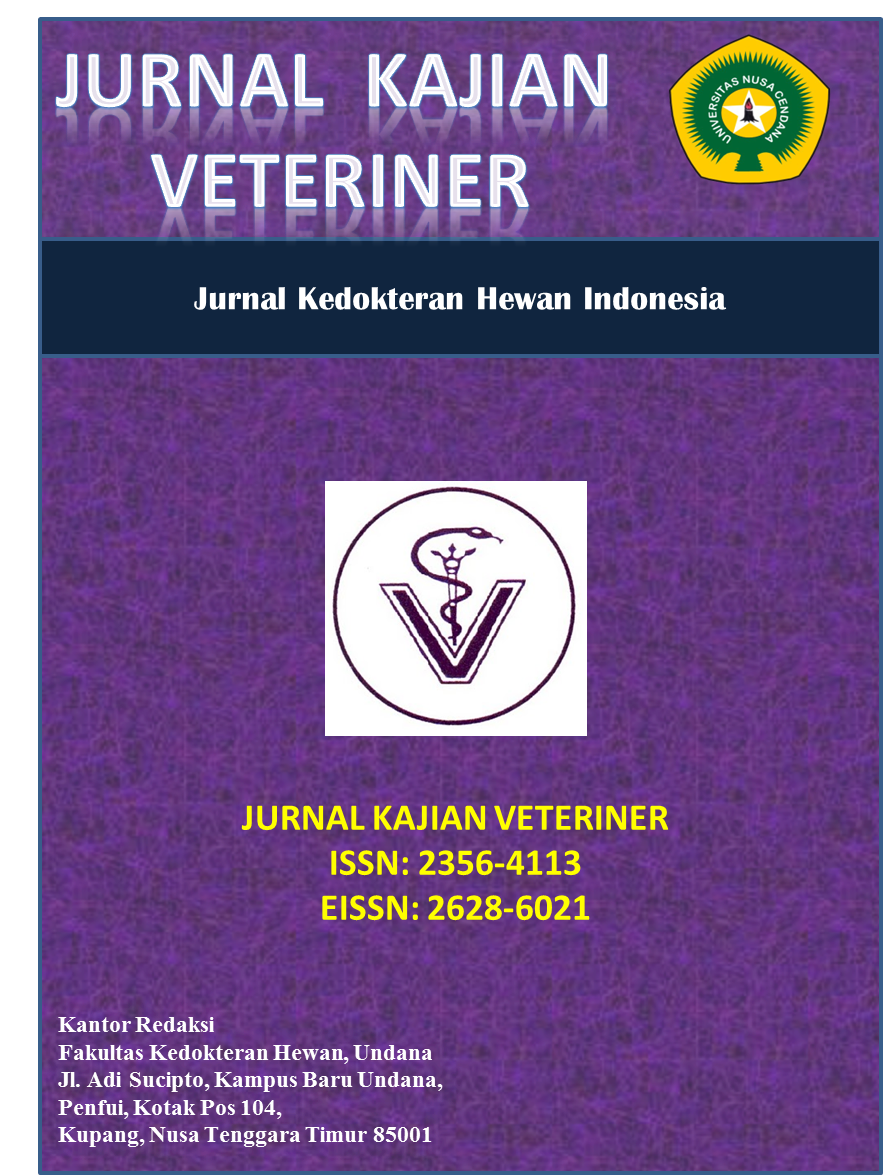KAJIAN HISTOKIMIA SEBARAN KARBOHIDRAT ASAM PADA LAMBUNG DEPAN SAPI SUMBA ONGOLE (Bos indicus)
A Histochemical Study Of Acid Carbohydrate Distribution Of Forestomach Sumba Ongole Cattle (Bos Indicus)
Abstract
Sumba ongole (Bos indicus) is one of the Indonesian local cattle breeds that has a high number of carcasses and good adaptability to the dry climate and low humidity on the island of Sumba. Cattle have a forestomach consisting of the rumen, reticulum, and omasum, which functions to ferment and absorb nutrition. This study aims to determine the distribution of acid carbohydrates in the rumen, reticulum, and omasum of sumba ongole cattle. Six samples of the rumen, reticulum, and omasum were collected from East Sumba Slaughter House, fixed in formalin 10 %, processed histologically, and continued with alcian blue (AB) staining. The result showed the various/different intensity of acid carbohydrates in each of the tunica of the rumen, reticulum, and omasum. The distribution is mostly found in the stratum corneum lamina epithelium. The results of this study indicate that the stratum corneum is the layer that is more frequently exposed to food that requires acid carbohydrates in its function to protect the forestomach as well as to lubricate the food to make it easier to digest.
Downloads
References
Ahmed S, Al-Asadi F. 2016. Histochemical study of mucopolyssacharides in stomach of buffalo(Bubalus bubalis). Basrah Journal of Veterinary Research 15 : 292–299.
Al-A araji A, Abood D. 2018. Histological and histochemical features of the fore stomach in indigenous gazelle ( Gazella subgutturosa ). Indian Journal of Animal Sciences 9 : 14573-14579.
Amleni LD, Amalo FA, Maha IT. 2019. Studi Histologis Rumen, Retikulum, dan Omasum Sapi Sumba Ongole (Bos indicus). Skripsi. Universitas Nusa Cendana : Kupang.
Masot AJ, Franco AJ, Redondo E. 2007. Comparative analysis of the forestomach mucosa in red deer during prenatal development. Revue de Medecine Veterinaire 158 : 397–409.
Neiva GSM, Da Mota DL, Batista ÂMV, Sousa-Rodrigues CF. Mucous Membrane of the Rumen of Ovines, Fed With Spineless, Forrage Cactus or Palm (Barbary Fig) (Opuntia ficus indica Mil): Hystochemical Study by Means of Light Microscopy. International Journal of Morphology 24 : 723–728.
Nurliani A, Pitojo BT, Kusindarta DL. 2015. Residu gula glikokonjugat pada lambung depan kerbau rawa (Bubalus bubalis). Jurnal Veteriner 15 : 166-172.
Parish J, Rivera J, Boland H. 2017. Understanding the Ruminant Animal Digestive System. Missisipi State University.
Schauer BYR. 1982. (Ed) Sialic acid: Chemistry, Metabolism and Function, Cell Biology Monograph, Volume 10. New York : Springer Verlag, Vien. Pp 263-305
Singh O, Sethi RS. 2012. Histochemistry of omasum of buffalo during prenatal development. Indian Veterinary Journal 89 : 52–55.
Stinson ALW, Calhoun ML. 1982. Sistema digestivo. In:Delman, H. D. & Brown, E. M. Histologia Veterinária : Guanabara Koogan, Rio de Janeiro. Pp 164 - 211.
Susanto E. 2013. Kajian suplementasi plant extract urea molasses multinutrient block (PE-UMMB) dalam ransum ternak ruminansia korban erupsi gunung berapi di Indonesia. Jurnal Ternak 4 : 26-38.
Suvarna K, Layton C, Bancrof J. 2005. Bancroft’s Theory And Practice Of Histological Techniques. ELSEVIER.
Wang J, Li H, Zhang L, Zhang Y, Yue M, Shao B, Wang J. 2014. Histomorphometric characterization of forestomach of yak (Bos grunniens) in the Qinghai-Tibetan Plateau. International Journal of Morphology 32 : 871–881.
Zitare I, Pilmane M, Jemeljanovs A. 2013. Histomorphology of the digestive system of red deer ( Cervus elaphus L .) in Latvia. Journal of Veterinary Medicine and Animimal Health 5 : 99-106.
Copyright (c) 2020 JURNAL KAJIAN VETERINER

This work is licensed under a Creative Commons Attribution-NonCommercial-NoDerivatives 4.0 International License.

 Theresia Bergita Paulino(1)
Theresia Bergita Paulino(1)








.png)


